Staff Reporter
Focus on Tire Recycling Renews as BEV Numbers Swell
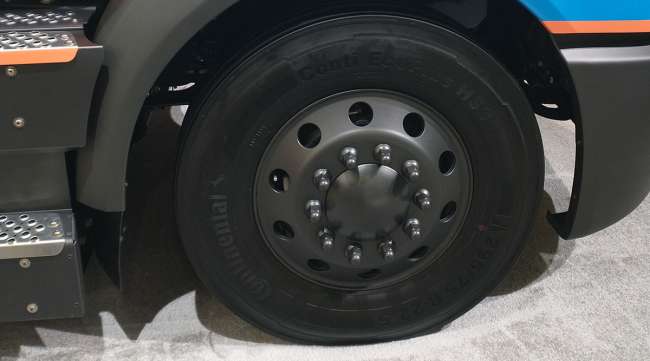
[Stay on top of transportation news: Get TTNews in your inbox.]
Retreading is a key instrument in a fleet manager’s cost management toolbox, but what happens after tires reach the end of their life span? Tires, specifically tire wear, are the most worrisome item for a trucking operation. And now, with the emergence of battery-electric and hydrogen fuel cell electric vehicles growing, the rate of tire wear also is accelerating.
One of the key selling points of electric vehicles is the instant and powerful torque and acceleration, although that instant power is hard on tires.
Freightliner’s best-selling traditional Cascadia internal combustion engine model, for instance, offers up to 2,050 pound-feet of torque. By comparison, the Daimler Truck North America unit’s Class 8 eCascadia tractor with a single-motor eAxle offers 11,500 pound-feet maximum torque, while the dual-motor eAxle option offers 23,000 pound-feet of maximum torque.
Compounding the concern, Honda introduced a range of seven passenger car and sports utility vehicles globally with electric powertrains, adding to the volume of rubber destined for the landfill or recycling.
RELATED: Honda Takes Wraps Off Class 8 Hydrogen FCEV Concept Truck
Passenger vehicles and light trucks push 250 million tires annually through one of those two options, said Andrew Meurer, chief commercial officer at Liberty Tire Recycling. Heavy-duty trucking adds a further 15% or nearly 40 million tires on top of that figure and off-road trucks another 5%, said Meurer, whose company is the largest tire recycler in North America, adding that EVs use tires at a 25% faster rate.
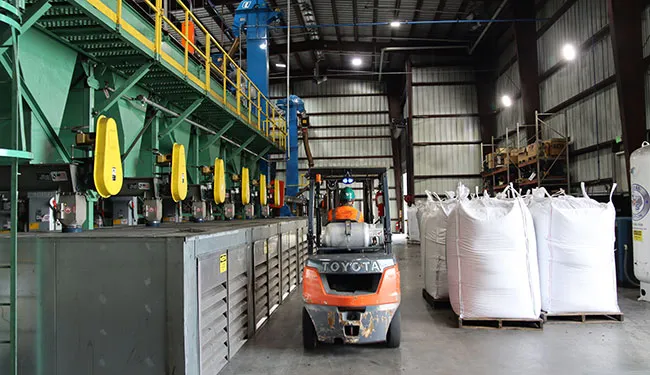
Inside a Liberty Tire Recycling plant. The company is the largest tire recycler in North America. (Liberty Tire Recycling)
Tire manufacturer Bridgestone has a seven-year warranty and retreading options, Director of Global Product Strategy for Retread Solutions Sanjay Nayakwadi told Transport Topics.
“A retread is one less tire that is manufactured, and one less tire kept out of the landfill. The more we can keep out of the landfill the better,” he said, adding that tires are inspected, cleaned up and then the retreaded tire is built. Retreading can reuse 70% of the tire.

Gust
“Fleets know retreading is the highest form of recycling,” Tire Industry Association CEO Dick Gust said, adding that a new tire has a 4.5 cents-per-mile lifetime cost while a retreaded tire has a 1.5 cents-per-mile cost. Also, new tires cost $150 to $200 more than a retread, he said.
“From a fleet standpoint, tires are probably your No. 1 cost maintenance item that you have to maintain throughout the year,” according to UPS Vice President of Maintenance and Engineering Anthony Marshall.
“One of the biggest metrics that any fleet is going to use, is, how long is the tire actually going to last? How many miles per 32nd [of tread depth] are you getting? Are you pulling the tires too early, too late? Are you validating to make sure the casing is in good wear condition? Are you following proper … techniques to make sure your casing can be reused?” Marshall said during the most recent Transport Topics Rotate magazine event series.

Marshall
UPS ranks No. 1 on the Transport Topics Top 100 list of the largest for-hire companies in North America and No. 4 on the TT Top 100 list of the largest logistics companies. It operates more than 120,000 vehicles, including more than 16,000 Class 8 tractors. The fleet expects 40% of its ground operations to be using alternative fuels by 2025. It also expects to be carbon neutral by 2050.
As a result, UPS’ tire wear is expected to appreciate.
Atlanta-based UPS currently recycles between 400,000 and 500,000 tires annually.
“At UPS, we recycle all our tires in two ways: Retreading the tire casings multiple times and recycling the tire at end of life,” a spokesperson said in response to TT questions. “They do not go into the landfill, and we have strict ‘cradle to grave’ process. Our tire recycling processes prevent landfill waste, reduce fossil oil usage, save energy and ultimately provide a cost benefit to the company.”
Setting a Recycling Path
Also, the tires for electric vehicles are set to be heavier as bigger tires are needed to deal with increased torque.

Meurer
“The market is changing in two fundamental ways,” said Liberty Tire Recycling’s Meurer. “The weight of tires and the volume of tires being recycled. The weight of the tires is changing because of the larger rim size of tires being used.”
A majority of tires recycled in 2020 had 15-inch, 16-inch and 17-inch rims, whereas in 2024 the majority have at least 18-inch rims with many as large as 22 inches, he said.
Rubber-modified asphalt (RMA), one of the main routes for recycled tires, is expected to ease that wear and tear and aid fleets’ profit and loss accounts.
RMA provides a smoother ride, increased surface durability, lower life cycle costs and emissions reductions — all while reducing traffic noise, according to advocates including TIA and Rubber Recycling Coalition.
The modern version of RMA has been around for around four years and is less expensive than regular asphalt, TIA’s Gust told TT, adding that the trade association wants to see rubber in every specification for asphalt.
At its Tire Recycling Conference in Atlanta in May, the U.S. Tire Manufacturers Association, in partnership with TIA, announced the formation of the Tire Recycling Foundation.
The initiative hopes to accelerate the adoption of RMA as well as secure funding and allocating grants for research, education, intervention and demonstration projects targeting critical knowledge and research gaps in the U.S. tire recycling supply chain.

Luke
The foundation’s primary goal is to recycle 100% of end-of-life tires into circular, sustainable markets.
“For the past 30 years, USTMA has advocated for sustainable end-of-life-tire management, but more work remains with only 71% currently recycled,” USTMA CEO Anne Forristall Luke said.
“Through the foundation and collaboration with our newly appointed board of directors, comprised of manufacturers, dealers, recyclers and transportation experts, we’re confident we can advance our goal of 100% circularity,” she added.
Those past 30 years coincide with the introduction of the Intermodal Surface Transportation Efficiency Act of 1991, a mandate that was swiftly withdrawn, and led to a healthy dose of skepticism among pavers in RMA that endures to this day, sources say.
Bill Buttlar, a professor in the University of Missouri’s civil and environmental engineering department, said at the Atlanta conference that RMA technology has changed considerably in the intervening period, introducing much finer rubber grains, smoothing out the binding process and eliminating poor process temperature control.
But pavers remain resistant as they continue to be wed to existing methods and low-cost operations, and the asphalt requires replacing less often with RMA incorporated, hurting vested interests’ business opportunities, Meurer said.
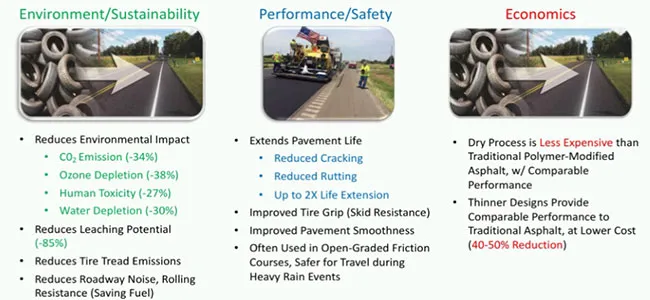
Some of the benefits of rubber-modified asphalt, according to University of Missouri professors Bill Buttlar and Punyaslok Rath’s “RMA Stake of Knowledge Study.” (Bill Buttlar)
That said, acceptance and encouragement is growing. The Low Carbon Transportation Materials grant program, part of the Inflation Reduction Act of 2022, is offering subsidies for use of RMA.
The two other main recycling paths for tires are tire-derived fuel (TDF) and tire-derived aggregate (TDA).
About 50% of TDF is used by cement kilns, while 29% is used by pulp and paper mills, and the other 21% by electric utility boilers. TDF has a high heating value and for many years accounted for a majority of the scrap tires being recycled. It was the first market for end-of-life tires.
Some 76 million tires were used for TDF in 2021, according to John Sheerin, USTMA senior director of end-of-life tire programs. The amount of tires used for TDF was stable between 2021 and 2023.
One-third of tires recycled is used for TDF, Sheerin said in a May 21 interview, although the volume of TDF produced fluctuates alongside the price of fuel.
Robby Hamby of Bridgestone Americas and Ken Eggen of Wolf River Express share how fleets should acquire the right tire monitoring tools for data collection. Tune in above or by going to RoadSigns.ttnews.com.
TDF consumption is limited by kiln capacity, a rigorous air permitting process for cement plants without existing TDF-burning approval, the mercury content of TDF, plus the amount of energy it requires to process the tires, Louis Baer, Portland Cement Association senior director for government affairs, said at the Atlanta conference.
The potential for TDA is even greater. “Tire-derived aggregate alone could consume every tire that is made,” Gust said. It can be used in the construction of embankments, retaining walls, parking lots, playgrounds, roads, park trails, railroad tracks, and more.
But concerns about the impact of a chemical known as 6PPD and about tire wear particles are holding back use. When 6PPD reacts with ozone, it forms 6PPD-quinone, which can be toxic to fish, according to studies.
USTMA commissioned research on finding alternatives to 6PPD, which prevents tires from breaking down due to reactions with ozone, saying in March it had narrowed down the potential candidates to five.
RMA, therefore, is the tire sector’s targeted growth area, befitting of its greater sustainability.
Tire Sustainability
In the meantime, tire companies are seeking to make the original tires fleets buy greener.
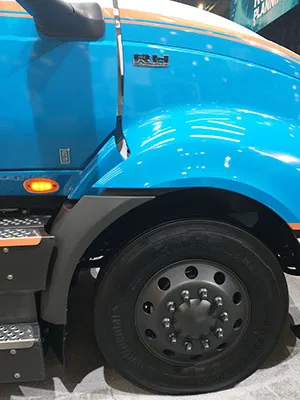
International RH battery-electric truck sporting Continental Ecoplus HTL2 tires. (Keiron Greenhalgh/Transport Topics)
“Michelin currently averages 30% renewable and recycled materials in its tires. By 2030, Michelin will bring the average renewable and recycled content of its tires up to 40%,” said Jim Garrett, a product manager for Michelin North America,. “In 2050, that figure will be 100% for all its tires, with no negative impact on tire performance or the environment.”
By 2030, Continental plans to use 60% sustainable materials in flagship products, source all natural rubber in its tire production from responsible sources and reduce its waste recycling rate by 95%, Continental Truck Tires U.S. Vice President Shaun Uys said in an email, citing the German tire maker’s Vision 2030 initiative.
Low-rolling-resistance tires also are increasingly deployed to improve fuel economy. According to the Department of Energy, rolling resistance due to tire flex can account for about 4% to 11% of the fuel consumption for a gasoline-powered vehicle and about 25% of the energy consumed by an EV.
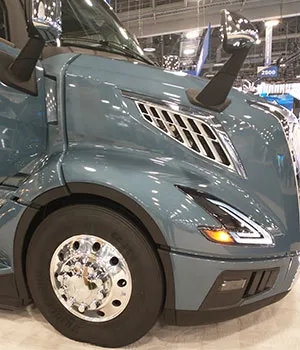
Volvo Trucks North America’s flagship VNL tractor sporting Bridgestone R213 tires. (Keiron Greenhalgh/Transport Topics)
International’s RH battery-electric truck was sporting a set of Continental Ecoplus HTL2 low-rolling-resistance tires at ACT Expo 2024 in Las Vegas. The recently launched Kenworth SuperTruck 2 also was equipped with the same tires at ACT 2024.
Volvo Trucks North America’s redesigned Class 8 flagship VNL was sporting Bridgestone R213s, another low-rolling-resistance tire.
Prices for truck tires from Tier 1 brands have remained firm as a result of such innovations, but this opened a door for cheaper brands.
Executives from Bridgestone and other Tier 1 suppliers in the U.S. bemoaned the impact of imported tires on their commercial vehicle tire sales in the past couple of quarters.
All the tires will need recycling at the end of their lives, though.
Want more news? Listen to today's daily briefing below or go here for more info:





